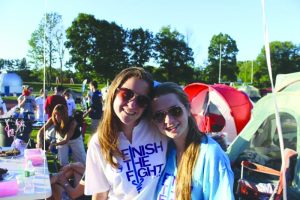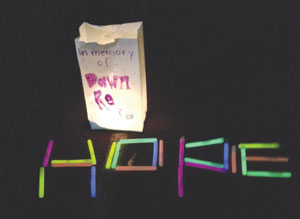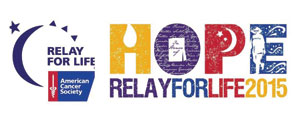
Vivian Kaiser at the 2014 Relay
Behind the Scenes of the Ultimate Community Fundraising Event
By Debra Hand
Celebrate. Remember. Fight Back.
On June 6th, hundreds upon hundreds of Chappaqua residents of all ages will descend upon the Horace Greeley High School track to take part in what is likely the largest–and perhaps the most moving–community event in town every year: the American Cancer Society’s (“ACS”) Relay for Life.
The Chappaqua Event Has Been Growing since 2008
Relay events span the globe, with team members taking turns walking all night to raise funds for cancer research. Food, games, activities and music build camaraderie and make every Relay the ultimate community event for a common cause. According to the ACS website, “each team is asked to have a representative on the track at all times during the event…because cancer never sleeps.”
The first Chappaqua Relay for Life was held in 2008, when three students who had participated in Fox Lane High School’s Relay to honor a stricken friend asked Greeley English teacher Amy Kaiser to be the faculty advisor for a HGHS club and event. That first year, the Chappaqua Relay drew 30 teams, over 300 participants, and raised over $70,000, surpassing its modest $30,000 goal.
The Greeley Relay, traditionally held the first weekend in June, has since grown exponentially, both in number of participants and funds raised. Last year, the event brought in approximately $160,000; the total raised in only seven years amounts to over $1,025,000, making the Chappaqua event one of the top Relays in the country every year since 2011, when it won the Number One Youth Award. With over 80 teams and close to 600 participants, from 8th graders through adults, the 2015 event will certainly reach its $170,000 goal.
Behind the Scenes: Months of Planning
No event of this magnitude happens without a good deal of organization. Shortly after the ACS October “Making Strides” Walk Against Breast Cancer, an ACS staff partner meets with Greeley organizers to set guidelines and a schedule. After a January kickoff ceremony, the school club, this year chaired by Greeley students Emma Meyer, Micaela Silver and Emily Kerstein, brainstorms activities and fundraising ideas.
“We are all really proud of our work this year and are so happy to be a part of Relay for Life. As co-chairs we organize the event for our town,” said Meyer. She adds, “Everyone is welcome to come support us to finish the fight against cancer!”

Relay for Life Committee Photo
Student subcommittees handle every detail: survivors’ dinner, entertainment, publicity (posters and social media), team recruitment, sponsorship and selling and decorating thousands of luminaria, paper bags to be filled with sand and candles honoring or remembering all loved ones.
Teams run fundraisers leading up to the event, including bake sales, car washes, yard sales, and jewelry or stationery creations and sales. The Chappaqua Relay, along with each team and individual participant, has a dedicated ACS webpage to help everyone solicit donations from family and friends.
ACS even offers various fundraising tips and incentives, such as Relay paraphernalia awarded for certain dollar amounts reached.
“Chaperones are the unsung heroes of Relay,” said Kaiser, who adds that the event “couldn’t happen without them.” Each youth team must have an adult who supervises overnight, and often those chaperones have friends offer to keep them company. “The community members do it for each other,” she said.
On “Bank Night,” money manually collected is submitted, t-shirts distributed, and campsites assigned. Logistics and paperwork are finalized; each “minor” participant must provide emergency contact information and chaperone confirmation.
In keeping with the community spirit of Relay, many local businesses provide goods and services, according to Kaiser: coffee and hot chocolate from Starbucks, the survivors’ dinner from Villarina’s, movie popcorn from the Jacob Burns Film Center, concession-stand ice cream from Ben & Jerry’s, and survivors’ dinner centerpieces from Whispering Pines.
The Day Arrives
At 8 a.m., Kaiser, the ACS liaison and the school Relay Executive Committee convene at Greeley to unpack and hang 200 signs brought by ACS, which also provides the large survivors’ tent, portable rest rooms, floodlights and lighting poles, all of which are delivered and assembled throughout the morning.
At 10 a.m., the 30-student planning committee begins arriving in shifts to plant stakes labeling the 80 campsites, inflate hundreds of balloons for a balloon arch, hang ACS banners, and ready the survivors’ and registration tents. Thousands of luminaria are filled with sand and placed around the track, and arranged on the bleachers to spell “HOPE.” The snack bar is set up for committee members to take shifts selling snacks like chips, pizza, soda and ice cream.
Between 4 and 6 p.m., participants arrive, register and assemble campsites. School custodians (also “unsung heroes,” said Kaiser), shuttle things on golf carts from parking lot to field, while the school DJ club provides music. Approximately 50 cancer survivors are served dinner, as young and old flood the field.
“Many people come to purchase luminaria for their loved ones so that they can decorate them personally and place it on the track themselves,” explained Kaiser.
The Survivor Lap: The Walk Begins
Relay officially begins at 7 p.m. with the inspirational Survivors’ Lap, accompanied by Melissa Etheridge’s song “I Run for Life;” survivors and their caregivers/families walk the track, wearing purple survivor shirts and sashes, as other participants and guests applaud.
“The first lap that the participants begin walking to was written by a Greeley graduate, Ben Silver (Micaela’s brother),” said Kaiser. “It’s a techno song called Relay that he wrote in order to raise money for Relay for Life at Tufts University when he graduated. It’s pretty awesome that we have our own song!”
Everyone then walks the track, and runs or visits campsite fundraisers such as penny candy sales, photo booth, dunk tank, wedding booth, “relay-grams,” and “lap trackers,” where a walker purchases a lanyard and receives a bead for each lap walked. The most popular and profitable fundraiser is usually the “jail” created by adjoining soccer nets: individuals pay $5 to have friends “arrested,” or $5 bail for their release.

Relay for Life Committee Photo
The Luminaria Ceremony: Honoring Those Lost
As darkness falls, the committee lights candles in the thousands of luminaria lining the track and on the bleachers, each one bearing the name of a person touched by cancer. Light sticks are distributed to everyone present, and the lights on the fields are turned off.
In an incredibly moving and brave ceremony, student speakers talk about their experiences with cancer, either having faced the disease themselves or having watched a parent battle. Kaiser said that the students often volunteer, and are free to speak as long as they’d like without restrictions or time limits. She notes how difficult it is to see students struggle with such heartache.
The assembled audience is then asked to snap their light sticks in memory of loved ones lost to cancer, by turns parents, children, siblings, friends and others. “Hearing the crack, the noise of the light sticks, is just heartbreaking,” said Kaiser. The Greeley Madrigal Choir sings while all present walk a silent lap around the track. The music is the only thing heard, the light sticks, luminaria, and the word HOPE on the bleachers the only illumination.
The Long Overnight
Guests leave by 11 p.m., after which only students cleared with proper permission may stay. Kaiser herself checks registration wristbands throughout the night. Teams take turns walking and sleeping, tossing a frisbee, or playing board games in their tents. A movie is screened in the survivors’ tent, the school Puritans improvisation troupe may perform, even a yoga class may be offered.
At 5 a.m., coffee and bagels are provided, total fundraising announced, and exhausted participants pack up and leave. Committee members stay until 9 a.m. to take down the signs and dismantle the tables and chairs.
“This is a very hardworking committee of students,” said Kaiser. “They’re the muscle, and they’re on all night, too.” Most Relay participants go on to walk in their college campus Relays as well.
“Why We Relay”
The ACS philosophy states it best: Relay For Life “represents the hope that those lost to cancer will never be forgotten, that those who face cancer will be supported, and that one day cancer will be eliminated.”
 Relay for Life is many things to many people: it is an affirmation of life for those who have beaten cancer, it honors those lost to the disease, it is a way of coming together as a community to fight back and raise funds to rid the world of a scourge that has touched everyone in some way. The Chappaqua community has shown its generosity time and again, and Relay for Life is no exception.
Relay for Life is many things to many people: it is an affirmation of life for those who have beaten cancer, it honors those lost to the disease, it is a way of coming together as a community to fight back and raise funds to rid the world of a scourge that has touched everyone in some way. The Chappaqua community has shown its generosity time and again, and Relay for Life is no exception.
To learn more about the Chappaqua Relay for Life or donate, click HERE.
Debra Hand is a longtime writer and editor for Inside Chappaqua. Her daughters have been on the Relay Planning Committee since 2011, and her husband has chaperoned twice (once in a very, VERY small tent).
